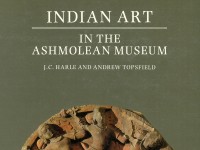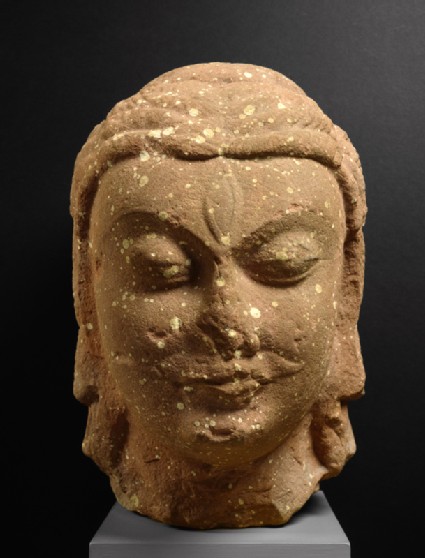Indian Art in the Ashmolean Museum
A catalogue of the Ashmolean’s collection of Indian art by J. C. Harle and Andrew Topsfield (published Oxford, 1987).

Publications online: 143 objects
- Reference URL
Actions
Head of Shiva
-
Literature notes
The Gupta period has been considered to be the Indian classical age in so far as, in Goetz’s words, “it aspired to create a perfect unsurpassable style of life”. Its art, like that of 5th century Athens, influenced sculpture for many centuries and in lands far away from India. For the first time Indian sculpture was able to suggest higher spiritual states, a turning inward of the subject and an air of self-absorbed introspection. New too is an ability to combine the earthy and dainty, a phrase of the same author.
Here the dainty treatment of Śiva’s hair contrasts with the massive sculptural conception of the head as a whole; it is a head “outstanding in the elemental power, controlled and concentrated, that informs its every plane and curve. Severe and serene meditation is conveyed by half-open eyes, their gaze steadied by reverberating curves of lids and brows and the deep shadows between their intersecting planes. Correspondingly, the strands of hair that spread out like wings of a soaring bird clasp the vaulted forehead and frame the face … Abdicating all sensuality, the austere forehead and eyes are in command of the full-cheeked face. Compassion and detachment hover around the lips – now damaged and moustached. The third eye – symbolically the seat of the fire of destruction – extending across the entire height of the forehead, is here an essential part of Śiva’s physiognomy. This head in indwelt by Śiva power; it is the god’s true likeness.”
Stella Kramrish has done full justice to one of the most impressive of all the known images of Śiva, Mahādeva or the great god. He and Viṣṇu represent the twin pinnacles of the Hindu pantheon, each with its subordinate deities and demi-gods. Whether the head belonged to a full-length figure of the god or projected from a mukha-liṅga, the primordial phallic symbol of Śiva, has not been finally decided. It has even been suggested that it was part of a bust, although this is an almost unknown form of sculpture in India. Nor is it certain whether the moustache was part of the original conception; if so it would point to an identification of the head with the fierce Aghora-bhairava, one of Śiva’s emanations. The way in which the matted locks of the ascetic are portrayed here, as individual ringlets, would support such an identification, although there is also a suggestion of a certain kind of wig, one of the Gupta period’s most urbane creations.
The stone is the spotted red sandstone of Mathura, and the style, with its unique blend of suavity and elemental plastic power, is unmistakably that of the Gupta period in its first full maturity. -
Description
This powerful head of Shiva, with ascetic’s locks and the third eye of yogic insight, may have belonged to a full-length image or else to a mukhalinga, the primordial phallic form of Shiva in which the face of the god projects from its side.
-
Details
- Associated place
-
Asia › India › north India › Uttar Pradesh › Mathura district › Mathura (place of creation)
- Date
-
early 5th century AD
Gupta Period (AD 320 - 600)
- Material and technique
- mottled red sandstone
- Dimensions
- 30.5 x 19 x 27 cm max. (height x width x depth)
- Material index
- Technique index
- Object type index
- No. of items
- 1
- Credit line
- Purchased with the assistance of Mr and Mrs Spalding and the Art Fund, 1939.
- Accession no.
- EAOS.38
-
Further reading
Harle, J. C., and Andrew Topsfield, Indian Art in the Ashmolean Museum (Oxford: Ashmolean Museum, 1987), no. 24 on p. 19, pp. xiii & 12, pl. 4 (colour) & p. 19
Harle, J. C., Gupta Sculpture: Indian sculpture of the Fourth to the Sixth Centuries A.D. (Oxford: Clarendon Press, 1974), 44-50
Philadelphia: Philadelphia Museum of Art, 29 March-7 June 1981, Manifestations of Shiva, Kramrisch, Stella (Philadelphia: Philadelphia Museum of Art, 1981), 15
Kramrisch, St., ‘Notes: 'Madhupāna' Scenes from Mathurā, etc.’, Journal of the Indian Society of Oriental Art, 6/June-December, (1938), pp. 200-202, pl. 44
Woodward, John, Treasures in Oxford (London: The British Council, 1951), 76, pl.76, fig.9
Saraswati, S. K., ‘Chapter XIX: Architecture’, R. C. Majumdar, A. D. Pusalkar, and A. K. Majumdar, eds, with a foreword by K. M. Munshi, The History and Culture of Indian People, iii: The Classical Age, 6 vols, The History and Culture of Indian People (Bombay: Bharatiya Vidya Bhavan, 1954), iii, 524, fig. 38
Harle, J. C., ‘The Head of Siva from Mathura in the Ashmolean Museum: Is the Moustache Recut?’, Asian Review, 2/April, (1965), 38
Kreisel, Gerd, Die Śiva-Bildwerke der Mathurā-Kunst: Ein Beitrag zur frühhinduistischen Ikonographie, Monographien zur indischen Archäologie, Kunst und Philologie, 5 (Stuttgart: Franz Steiner Verlag Wiesbaden, 1986), no. 90a-c on pp. 226-227, pp. 97, 107, 119, & 139, pls 90a-c
Piper, David, and Christopher White, Treasures of the Ashmolean Museum: An Illustrated Souvenir of the Collections, revised edn (Oxford: Ashmolean Museum, 1995), no. 37 on p. 41, illus. p. 41 fig. 37
Oxford: Ashmolean Museum, 24 May 2006-23 December 2008, Treasures: Antiquities, Eastern Art, Coins, and Casts: Exhibition Guide, Rune Frederiksen, ed. (Oxford: Ashmolean Museum, 2006), no. 173 on p. 62, illus. p. 62
Branfoot, Crispin, ‘Pilgrimage in South Asia: Crossing Boundaries of Space and Faith’, Ruth Barnes and Crispin Branfoot, eds, Pilgrimage: The Sacred Journey (Oxford: Ashmolean Museum, 2006), p. 46, illus. p. 47 fig. 38
Oxford: Ashmolean Museum, 2006, Pilgrimage: The Sacred Journey, Ruth Barnes and Crispin Branfoot, eds. (Oxford: Ashmolean Museum, 2006), pp. 46 & 47, illus. p. 47 fig. 38
Ahuja, Naman, ‘Early Indian Art at the Ashmolean Museum - Catalogue in progress’, 2016, no. 113
Location
Objects are sometimes moved to a different location. Our object location data is usually updated on a monthly basis. Contact the Jameel Study Centre if you are planning to visit the museum to see a particular object on display, or would like to arrange an appointment to see an object in our reserve collections.
Galleries
Publications online
-

Indian Art in the Ashmolean Museum
The Gupta period has been considered to be the Indian classical age in so far as, in Goetz’s words, “it aspired to create a perfect unsurpassable style of life”. Its art, like that of 5th century Athens, influenced sculpture for many centuries and in lands far away from India. For the first time Indian sculpture was able to suggest higher spiritual states, a turning inward of the subject and an air of self-absorbed introspection. New too is an ability to combine the earthy and dainty, a phrase of the same author.
Here the dainty treatment of Śiva’s hair contrasts with the massive sculptural conception of the head as a whole; it is a head “outstanding in the elemental power, controlled and concentrated, that informs its every plane and curve. Severe and serene meditation is conveyed by half-open eyes, their gaze steadied by reverberating curves of lids and brows and the deep shadows between their intersecting planes. Correspondingly, the strands of hair that spread out like wings of a soaring bird clasp the vaulted forehead and frame the face … Abdicating all sensuality, the austere forehead and eyes are in command of the full-cheeked face. Compassion and detachment hover around the lips – now damaged and moustached. The third eye – symbolically the seat of the fire of destruction – extending across the entire height of the forehead, is here an essential part of Śiva’s physiognomy. This head in indwelt by Śiva power; it is the god’s true likeness.”
Stella Kramrish has done full justice to one of the most impressive of all the known images of Śiva, Mahādeva or the great god. He and Viṣṇu represent the twin pinnacles of the Hindu pantheon, each with its subordinate deities and demi-gods. Whether the head belonged to a full-length figure of the god or projected from a mukha-liṅga, the primordial phallic symbol of Śiva, has not been finally decided. It has even been suggested that it was part of a bust, although this is an almost unknown form of sculpture in India. Nor is it certain whether the moustache was part of the original conception; if so it would point to an identification of the head with the fierce Aghora-bhairava, one of Śiva’s emanations. The way in which the matted locks of the ascetic are portrayed here, as individual ringlets, would support such an identification, although there is also a suggestion of a certain kind of wig, one of the Gupta period’s most urbane creations.
The stone is the spotted red sandstone of Mathura, and the style, with its unique blend of suavity and elemental plastic power, is unmistakably that of the Gupta period in its first full maturity.
Notice
Object information may not accurately reflect the actual contents of the original publication, since our online objects contain current information held in our collections database. Click on 'buy this publication' to purchase printed versions of our online publications, where available, or contact the Jameel Study Centre to arrange access to books on our collections that are now out of print.
© 2013 University of Oxford - Ashmolean Museum




